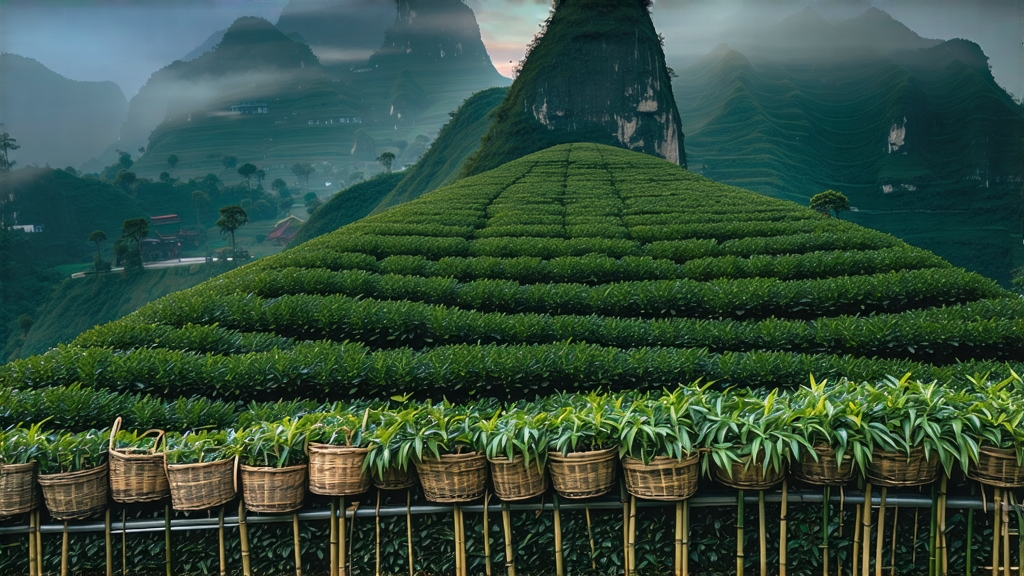
Tucked away in the humid, karst-pitted mountains of southern Guangxi province, Liu Bao cha has spent four centuries quietly perfecting the art of microbial alchemy. While Pu-erh has become the global shorthand for “dark tea,” Liu Bao is the older, subtler sibling—fermented, pressed, and sent down the Xi River to Hong Kong and Southeast Asia long before Yunnan’s famous cakes ever boarded a mule caravan. International drinkers are only now discovering that this inky, camphor-kissed liquor carries the taste of subtropical fog, ancient trade routes, and the slow patience of bamboo baskets.
Historical footprints
The name Liu Bao literally means “six forts,” a cluster of hamlets in Wuzhou prefecture where the tea was first bartered for salt and copper during the Ming dynasty. By the Qing, Liu Bao had earned imperial tribute status; court physicians praised its ability to “cut grease” after heavy Manchu meals. The real fame, however, came via the Tea Horse Road’s watery cousin: the Pearl River system. Compressed into 40 kg wicker baskets, the leaves sailed downstream to Guangzhou, then outward to Malaya, where tin-mine coolies and schooner crews adopted it as an antidote to malaria and monotony. In 19th-century Penang, Liu Bao was poured thick and sweet into tin cups, a world away from the gongfu rituals now performed in Berlin cafés.
Micro-terroirs within one county
Guangxi’s subtropical monsoon climate gifts Liu Bao three distinct leaf sources. The highest, at 800–1,000 m, is the mist-shrouded Da Wu Shan, where wild tea trees root directly into limestone fissures; the leaf is small, mineral, and laced with orchid fragrance. Mid-elevation terraced gardens around Liubao town yield broader leaves that carry the classic “betel-nose” note—an earthy sweetness reminiscent of areca nut. Finally, the lowland village of Xia Ping harvests bold, thick leaves prized for their ability to withstand repeated wet-piling without collapsing into mulch. Blenders marry all three to achieve the signature layered complexity that unfolds over a dozen infusions.
From green to black through living piles
Unlike Pu-erh’s sun-dried maocha, Liu Bao begins with a brief wok kill-green at 280 °C, just enough to halt oxidation enzymes while preserving surface microbes. The hot leaves are then rolled, breaking cell walls to release catechins and amino acids, and immediately piled 70 cm deep in bamboo-lined pits. Here the magic begins: indigenous Bacillus subtilis and Aspergillus niger populations bloom, raising internal temperature to 55 °C within 36 hours. Every 48 hours the pile is turned, sprayed with mountain spring water, and covered with jute sacks to maintain 80 % humidity. After 25–30 days the leaf has turned obsidian; a single kilo has lost 200 g in water yet gained millions of beneficial colony-forming units. A final low-temperature bake fixes the color and arrests further fermentation, leaving the tea microbiologically alive but culinarily stable.
Basket aging, the slow university
Post-fermentation, the tea is steamed soft, then hand-tamped into plaited bamboo baskets lined with wild banana leaf. These baskets breathe; over decades they allow a gentle exchange of air and moisture that rounds off rough edges. A 1980s basket Liu Bao displays camphor, nutmeg, and a hint of dried longan, whereas a 2018 vintage still trumpets wet earth and cacao nibs. Connoisseurs speak of “three transformations”: the green-to-dark in the pile, the dark-to-smooth in the first five years, and the smooth-to-ethereal after fifteen. The most sought-after lots are those that travelled by boat—salt spray and bilge air imprinted a maritime note impossible to replicate in modern climate-controlled warehouses.
Gongfu brewing for the western kitchen
You do not need a yixing pot carved in 1920 to enjoy Liu Bao; a simple 150 ml porcelain gaiwan does justice. Start with 5 g of leaf—about two heaping teaspoons of the loose variety or one 8 g mini-brick if you have the compressed “tea candy.” Rinse for three seconds with water just off a rolling boil; this